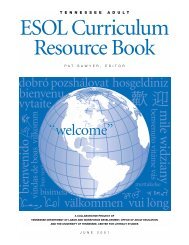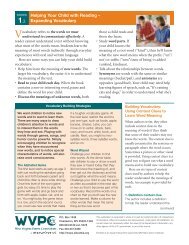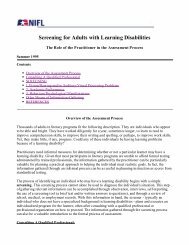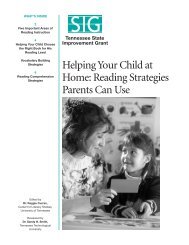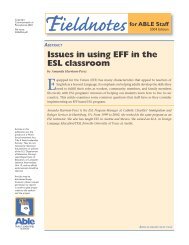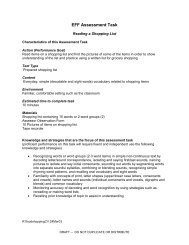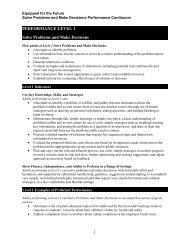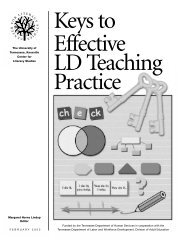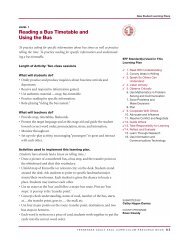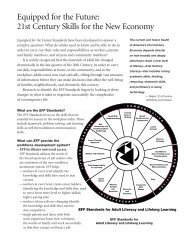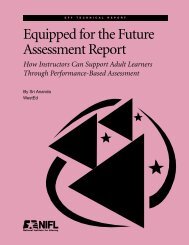Building Bridges Between School and Home - Center for Literacy ...
Building Bridges Between School and Home - Center for Literacy ...
Building Bridges Between School and Home - Center for Literacy ...
- No tags were found...
Create successful ePaper yourself
Turn your PDF publications into a flip-book with our unique Google optimized e-Paper software.
<strong>Building</strong> <strong>Bridges</strong><strong>Between</strong> <strong>School</strong><strong>and</strong> <strong>Home</strong>:Stories of Success fromLawrence County,TennesseeuContents1Introduction3Surveying to Invite Parent Involvement5Grade-level Meetings Help Parent-Teacher Communications6Introducing Parent Involvement Kits at Parent-Teacher Conference Night7In<strong>for</strong>ming Parents of Their Child’s Academic Per<strong>for</strong>mance9Helping Parents Support Their Children’s <strong>Literacy</strong> Development10Helping Parents Learn More About DIBELS Progress Monitoring11Lessons LearnedAPPENDICES15Appendix I: Leoma Elementary <strong>School</strong> 2007/2008 Parent Volunteer Form16Appendix II: Working With Teachers <strong>and</strong> <strong>School</strong>s19Appendix III: 1st Grade Progress Report20Appendix IV: DIBELS22Appendix V: References
could be expected in each session. During the finalface-to-face session, educators reflected on <strong>and</strong>summarized their learning.Course ContentThe course included two on-site sessions <strong>and</strong> threeonline sessions. Each session had specific topics, including:Science of Family Involvement <strong>and</strong> Communication;Promoting Positive Parenting; EnhancingStudent Learning; Celebrating Diversity:<strong>and</strong> Tying it all Together. Activities <strong>for</strong> each sessionincluded a pre-test to evaluate prior knowledge, articlesabout family involvement, discussions, casestudies, self-reflections, <strong>and</strong> a post-test to evaluatelearning, as well as h<strong>and</strong>outs that could be copied<strong>and</strong> distributed to teachers <strong>and</strong> to parents. The firstsession took place on-site at Lawrenceburg Elementary<strong>School</strong> in August, 2007, with on-line sessions inSeptember, October, <strong>and</strong> November. Our final session,held in December 2007, pulled together theacademic content <strong>and</strong> teachers’ experiences.Components of the course included:• An overview of parent/family involvement research• Individual <strong>and</strong> small group work in a variety ofactivities to provide self-assessment <strong>and</strong> pinpointwhere individual improvements could be made infamily/school partnerships• Discussion of expectations <strong>for</strong> family involvementin school <strong>and</strong> classroom activities• Creation of a plan <strong>for</strong> a family involvement projectin each teacher’s school, with subsequent reportson actions taken during the semesterCourse ParticipantsThe participants in this course included teachers<strong>and</strong> instructional coaches from six different schools,with an average of 20 years of teaching experience.The participants became involved in this coursebecause they wanted to reach out to the parents ofLawrence County <strong>and</strong> improve parent involvementin the schools. The participants knew that a relationshipbetween parents <strong>and</strong> teachers was crucialto the success of the students <strong>and</strong> the schools. Althougheach of the participants had taken steps tomake parents a top priority in their schools, they feltthey could benefit from additional training <strong>and</strong> in<strong>for</strong>mationabout parent involvement.At the first session, each participant selected aproject that she wanted to develop at her own schoolduring this time period. These plans became actionresearch projects that could be discussed <strong>and</strong> updatedduring the course timeline. The following storieschronicle the challenges, successes, <strong>and</strong> lessonslearned that each participant encountered whilecompleting their action research project.BUILDING BRIDGES BETWEEN SCHOOL AND HOME: STORIES OF SUCCESS FROM LAWRENCE COUNTY, TENNESSEE2
u Surveying to Invite Parent Involvement uWhen I began thisstarted the year be<strong>for</strong>e. So,job as the FamilyEngagement(See Appendix I) to againI sent out a shorter surveycoordinator three years ago,I conducted a survey of theparents because I wantedto know how com<strong>for</strong>tableparents were inside ourschool. I wanted to knowthe com<strong>for</strong>t level of theparents when they enteredthe office, our cafeteria,our classrooms, <strong>and</strong> our library.gather volunteer in<strong>for</strong>mation.I processed the surveys,<strong>and</strong> I arranged the resultsby who was willing towork in various areas — <strong>for</strong>example, who was willing towork in the library <strong>and</strong> whowas willing to work with thePTO. I even had “l<strong>and</strong>scaping”on the survey. I had aThe survey asked how often theyplace <strong>for</strong> stay-at-home moms whoJamie Glass,volunteered. Had they offered to volunteer?Did the school call after they vol-were willing to do whatever was needed<strong>and</strong> the days they were willing toInstructional Coachunteered? I wanted to know what theyhad to offer. I gave a three page survey,which I found out very quickly was toolong <strong>and</strong> not well written. I spent hours<strong>for</strong> Leoma Elementary<strong>School</strong>, has over 20 yearsexperience as an educator.Leoma Elementary servesvolunteer.My original idea was to put thisin<strong>for</strong>mation on the school’s websiteso teachers could easily pull up the listtallying the results.Pre-K through 8th gradeto see who had volunteered <strong>for</strong> what.The next year I decided to give aHowever, I was unable to do this duewith over 550 students.different survey. This time the surveyto security concerns. Instead, I createdwas much shorter <strong>and</strong> focusedmore toward parent volunteering. I decided to focusthis survey on volunteering because I saw thesame parents being utilized over <strong>and</strong> over again.I was beginning to hear animosity from parentswho wanted to be involved, but said they weren’tcalled. So my goal was to figure out how to takecare of that problem. I sent the survey out to allthe parents asking what skills they had to share<strong>and</strong> what days they could volunteer. After theparents returned the surveys, I had a nice, overwhelmingstack of surveys but wasn’t able to doanything with them because other projects cameup. So this year I gave yet another survey, <strong>and</strong> myaction project became a project to finish what Ia master list <strong>for</strong> the teachers that includedthe parents of their classrooms. I gave copiesto the library, the PTO, <strong>and</strong> the office — essentiallyone <strong>for</strong> all the different areas <strong>for</strong> when I asked volunteers.I sent a list to the teachers, along with a noteencouraging them to utilize each parent volunteerinstead of calling on the same ones over <strong>and</strong> over.Continually using the same parents is underst<strong>and</strong>ablebecause it is easier <strong>for</strong> the teachers if the parentsalready know how to do what it is they are beingasked to do. It is easier to call them <strong>and</strong> ask them tocome in than to have a trainer or a mentor to comein to mentor another volunteer. It’s just easier to callthe same ones. So I encouraged teachers to utilizeeach volunteer even though it might mean a little ex-BUILDING BRIDGES BETWEEN SCHOOL AND HOME: STORIES OF SUCCESS FROM LAWRENCE COUNTY, TENNESSEE3
tra work <strong>for</strong> them. I underst<strong>and</strong> why teachers preferto use the same volunteers again <strong>and</strong> again. For instance,when there is a field trip <strong>and</strong> chaperones areneeded, the teachers want chaperones who are dependable,trustworthy, <strong>and</strong> helpful. So,while I fully underst<strong>and</strong> why the teachersgo with the same volunteers, I alsounderst<strong>and</strong> the need <strong>and</strong> importance ofgiving every parent the opportunity tohelp. However, I stressed to the teachersthat it is important to extend the ef<strong>for</strong>tto all parents who say they would like tovolunteer. Periodically, I sent memos tothe teachers: Remember the volunteerlist? Have you lost yours? Do you needanother copy? Have you contacted allthe parents?My goal is <strong>for</strong> every parent who had volunteeredto be utilized at least one time. Even if it is just somethingsmall, it is important that each parent receivean opportunity to contribute. At the end of the year,I plan on distributing another survey to the parents(<strong>and</strong> one to the teachers) to find out what I can do tomake the volunteer list easier <strong>for</strong> the teachers to use<strong>and</strong> to find out from the parents if they felt the volunteerprogram was successful. Did you volunteer?Were you called? Were you able to come? Was therea reason why you couldn’t? What can we do to help?The feedback I have received from the teachers so farhas been very positive. My only concern is whetherthe teachers are still using the same volunteers over<strong>and</strong> over or if they include everyone.Another thing that grew out of this survey wasa focus on our parent involvement in other ways.The response to the question which asked, ‘How“My goal is <strong>for</strong> everyparent who volunteeredto be utilized at leastone time. Even if it isjust something small,it is important thateach parent receivean opportunity tocontribute.”com<strong>for</strong>table do you feel in our library?’ was mostlynot applicable.This response alerted us to the fact that we don’t oftenoffer activities that bring parents into our library.Now, when we have family nights, weschedule activities in the library so parentshave the opportunity to visit. Thiswas an interesting situation which mayhave gone unnoticed if we hadn’t administeredthe survey.I was also able to distribute statisticsto the teachers to show how the parentsfeel in various areas of our school. Thisallows us to identify what we can do tomake the parents feel more com<strong>for</strong>tablein the school.I learned from my previous surveys to narrow thein<strong>for</strong>mation down so it was manageable. I was justa little overzealous with the first surveys because Iwanted to collect as much in<strong>for</strong>mation as possible<strong>and</strong> didn’t even anticipate the amount of work <strong>and</strong>time it would take to compile the results. It wasn’ta bad survey; it was a great survey. It was just toomuch.I am proud of this project because I establisheda database of volunteers, their skills, <strong>and</strong> wherethey’re willing to volunteer. That in itself is a hugefeat, but then I also think of all the other thingsI did, like sharing data so teachers can make improvementsin the school <strong>and</strong> classrooms to helpparents feel welcome. This project also brought upthe issue of the importance of using all parents <strong>and</strong>not just a select few. This project became so muchmore than just creating a database of volunteers.It’s pretty impressive.BUILDING BRIDGES BETWEEN SCHOOL AND HOME: STORIES OF SUCCESS FROM LAWRENCE COUNTY, TENNESSEE4
u Grade-level MeetingsHelp Parent-Teacher Communications uFor our project, we developed agrade-level meeting night. Theactivity was to provide an opportunity<strong>for</strong> parents to find out fromthe teachers what was expected of them<strong>and</strong> their children. Communicationcan be a real issue at our school. Wesometimes have difficulty getting parentsto come in — especially those weneed to speak with. Like most schools,we are constantly changing programs,curriculums, <strong>and</strong> expectations.We can’t assume the parents underst<strong>and</strong>it just because we do. Wesend home in<strong>for</strong>mation <strong>and</strong> providein<strong>for</strong>mation at conferences. However,we have begun to realize that too oftenwe aren’t giving them enough in<strong>for</strong>mationor reaching enough of theparent population. So we decided tobegin our meeting by giving somegeneral in<strong>for</strong>mation first <strong>and</strong> then sending parentsto their grade-level sessions. This way, the teacherscould talk with them <strong>and</strong> they could ask questions<strong>and</strong> find out more about the expectations at eachgrade. We’ve found that what parents expect <strong>and</strong>what teachers expect are often very different. I wishwe had scheduled the meeting earlier in the year. Bythe time we had the meeting, too many misunderst<strong>and</strong>ingshad already taken place, so we spent mostof the time trying to clear up things <strong>and</strong> there<strong>for</strong>ecouldn’t focus on what we really needed to do. Ourparticipation <strong>for</strong> this meeting was rather good. Thiswas a new type of meeting <strong>and</strong> there were a lot ofpeople there who had no idea what to expect. Someparents come to our meetings regularly <strong>and</strong> somedon’t. I believe our turnout <strong>for</strong> this meeting washigher because we provided food. Participation isKaye Allen is aninstructional coachat Ingram SowellElementary <strong>School</strong> <strong>and</strong>has 33 years of teachingexperience.always higher when we provide foodbecause this allows parents to come bytaking two things off their already hecticplate: preparing dinner <strong>and</strong> the costof a meal.After the meal, parents went tothe individual rooms to meet with theteachers. The teachers prepared a list ofst<strong>and</strong>ards they are responsible <strong>for</strong> teaching.They also prepared a list of the assessmentsthat they used. The teacherssaid they were able to get through mostof the in<strong>for</strong>mation they prepared, butmost parents were focusing on questionslike: How do you do homework?Because this question is so general, itwas hard to address in the short period.One accomplishment of the nightwas that we encouraged the parents tocome back to parent-teacher conferencesso that they could have an individualconference to address their specific questions. Becausewe were trying to reach all parents with thismeeting, we couldn’t take the time to address specificquestions about individual children. The in<strong>for</strong>mationwe gave was general, such as our expectations<strong>for</strong> first grade. There<strong>for</strong>e, parents didn’t feel like theyhad enough time in one place. I think they also feltinhibited about what to ask <strong>and</strong> felt a little apprehensiveabout asking questions in front of the otherparents. During the meeting I provided parents witha copy of the Parent Guide <strong>for</strong> Working with Teachers(Appendix II). I wish I had distributed these prior tothe meeting because I think they parents would havebeen more in<strong>for</strong>med about what to ask.I’ve received a lot of good feedback since the sessionbecause parents have actually asked questionslisted in the Guide.BUILDING BRIDGES BETWEEN SCHOOL AND HOME: STORIES OF SUCCESS FROM LAWRENCE COUNTY, TENNESSEE5
u Introducing Parent InvolvementKits at Parent-Teacher Conference Night uLast year, we spent someof our Title I moneyon items that teachersthought would be good classroom<strong>and</strong> parent involvementactivities. After researchingmany products, the teacherschose Frog Family Fun Packs.These kits encourage parentinvolvement while their childpractices a particular skill. Thekits have different skills <strong>for</strong> thechild to practice <strong>and</strong> offer activitiesthat parents can complete withtheir child. We selected kits <strong>for</strong> first,second, <strong>and</strong> third grade. The goal wasto train the child <strong>and</strong> parents on howto use the activities in the kits. The kitswould eventually go home with thechild each week so the parents <strong>and</strong> childcould complete the activities <strong>and</strong> playthe games together. We received the kitsat the end of last year <strong>and</strong> we put them on the shelfuntil we could decide how to incorporate the kits inour parent involvement program this year.We decided to introduce the kits during ourparent-teacher conferences. The night of the conferenceswe offered different sessions that parentscould attend while waiting <strong>for</strong> their opportunity tomeet with their child’s teacher. I wanted to revampthe way we had been offering the traditional parentteacherconference. I wanted the night to offer somethingmore than just going to see the teacher. Oftenthere are long lines of parents in the halls, waiting tosee teachers <strong>and</strong> they are just sitting there <strong>and</strong> gettingfrustrated. I thought if they had some other activitiesto rotate to while waiting — <strong>and</strong> could gainknowledge at the same time — it would make <strong>for</strong> aMichelle (Shelly)Campbell was aninstructional coach withLawrence CountyPublic <strong>School</strong>s <strong>and</strong> hasrecently retired.smoother flow. Plus, the parentswould feel more involved<strong>and</strong> there would be morethings going on while the parentswait.My Title I assistant <strong>and</strong> Iworked on signs <strong>and</strong> schedulespromoting the Frog FamilyFun Pack session. Parentscould attend this session <strong>and</strong>learn more about the FrogFamily Fun Packs <strong>and</strong> learnhow to do the activities. Weoffered tootsie rolls (600 of them) toparents to entice them to attend this session.The evening started off somewhatslowly <strong>and</strong> we had very few participantsin the beginning. But as the night wenton, more parents came in <strong>for</strong> conferences<strong>and</strong> more came in to the Fun Packsession. The parents seemed to have areally good time with the activities <strong>and</strong>we considered the night a success.However, that is as far as the project has progressed.We have completed the introduction <strong>and</strong>training on the Frog Family Fun Packs, but we needto carry it on to the next step. We are in the processof deciding where to locate the Fun Packs, whichteachers are going to use them, how we are goingto go about scheduling use of the Fun Packs, howwe are going to spread the word that they are available,<strong>and</strong> how we will get them home <strong>and</strong> get themreturned. The kits are still sitting in the boxes asof now. The parents have had the opportunity towork with the kits <strong>and</strong> know a little bit about whatto expect.If I were going to carry out this project again, Iwould do a few things differently. Because I didn’tBUILDING BRIDGES BETWEEN SCHOOL AND HOME: STORIES OF SUCCESS FROM LAWRENCE COUNTY, TENNESSEE6
have the turnout I expected, I would probably putmore thought into sending in<strong>for</strong>mation out to particulargroups of parents instead of just sending outa school-wide notice of the schedule. I would putmore ef<strong>for</strong>t into recruiting the groups of parentsthat would benefit most from having this in<strong>for</strong>mation,such as 1st through 3rd grade parents. I wouldalso keep up the momentum instead of getting it going<strong>and</strong> letting it fizzle. It is hard to find the time toget it going again. Sometimes we have really goodideas but we don’t always have the time or resourcesto carry them out.u In<strong>for</strong>ming Parents ofTheir Child’s Academic Per<strong>for</strong>mance uOne of the things thatthe teachers in myschool are reallyconcerned about is how effectivelywe communicate howstudents are per<strong>for</strong>ming insubject areas. In order to helpparents underst<strong>and</strong> how theirchild is per<strong>for</strong>ming in school,we decided to supplement thereport cards. We developedprogress reports that we send toparents between report cards. Theseprogress reports show parents howtheir child per<strong>for</strong>med on assessments.However, when we looked atthe progress reports, we noticed thatwe gave parents a lot of in<strong>for</strong>mationbut we didn’t clearly define whatthe assessments were <strong>and</strong> what theymeasured. So, to effectively communicate how theirchild was per<strong>for</strong>ming, we started setting up in<strong>for</strong>mationalmeetings. We brought parents in <strong>for</strong> a session<strong>and</strong> gave a presentation on Dynamic IndicatorsPatty Welsh has over 20 yearsof teaching experience <strong>and</strong> asan instructional coach. She iscurrently a Title I teacher atSouth Lawrence Elementarywhich serves over 700 pre-Kthrough 8th grade students.of Basic Early <strong>Literacy</strong> Skills(DIBELS). During this sessionwe explained the components,defined some of the terminology,explained the benchmark<strong>and</strong> goals, <strong>and</strong> provided activities<strong>and</strong> strategies that parentscould do at home to helptheir child. We also explainedthe tier work that we did inthe classroom.While the parents were in the DI-BELS presentation, the childrenwere working on Halloween activities.After the presentation, the childrencame back in <strong>and</strong> completedan AR (Accelerated Reader) computeractivity with their parent. Wegave each child <strong>and</strong> parent a book<strong>and</strong> they spread all throughout thebuilding, reading together. They sat on the floor,or wherever they could find a com<strong>for</strong>table spot toread the book. After they read, we explained ARgoals, what was expected of them, how the systemBUILDING BRIDGES BETWEEN SCHOOL AND HOME: STORIES OF SUCCESS FROM LAWRENCE COUNTY, TENNESSEE7
worked in the classroom <strong>and</strong> how it factored intotheir grades. Then we let the parents <strong>and</strong> childrentake the AR assessment. Parents really liked the interactivesession. They loved working with the computers,they got h<strong>and</strong>s-on experience,they received a free book, <strong>and</strong> theywere able to read together with theirchild. The children were so excited thatthey wanted to continue working withtheir parents on the AR activities. Theywanted to show their parents all aboutthe AR program.Although we considered the night asuccess, I was disappointed because we were tryingto present too much in<strong>for</strong>mation in too little time.We felt like we weren’t able to adequately answer thequestions that the parents had because of the massiveamount of in<strong>for</strong>mation we were trying to present. Wewere trying to do everything with this one DIBELSmeeting <strong>and</strong> we should have broken it down into severalsmaller sessions.In the past we weren’t happy with the grades wewere giving out because we kept saying we’re givingthem an ‘E,’ but these kids still have problems thatare not identified. So, when we sent out the firstprogress report, the teachers were apprehensive becausewe were being very honest with the parentsabout their child’s level of per<strong>for</strong>mance. However,after the reports went home the teachers began receivingnumerous phone calls from parents seekinghelp. They wanted to know how to help their child.The parents asked teachers what needed to be done“My project was reallyabout improvingcommunication with theparents so they wouldknow more than just aletter grade.”to help improve their child’s skills <strong>and</strong> per<strong>for</strong>mance.So providing this in<strong>for</strong>mation really did cause parentsto become more involved. They asked <strong>for</strong> help<strong>and</strong> the teachers were able to give it to them. Whenthe teachers saw the end result, theysaid that students were no longer fallingthrough the cracks. Problems wereidentified earlier on. This allowed us toindividualize our instruction <strong>and</strong> targetthe students’ weaknesses. Teachers wereable to work more closely with the lowper<strong>for</strong>mance groups while the studentswho were per<strong>for</strong>ming on or abovegrade-level work independently.My project was really about improving communicationwith the parents so they would knowmore about their child’s per<strong>for</strong>mance than just aletter grade. Instead, they would know what theirchild was doing <strong>and</strong> learning <strong>and</strong> how well theywere actually per<strong>for</strong>ming. We developed a rubric(Appendix III) so parents could tell what theirchild’s needs were <strong>and</strong> how to help in areas wherethey struggled. The progress reports specify thestrengths <strong>and</strong> weaknesses of the student <strong>and</strong> giveparents strategies.When we do this again we will probably havegrade-level meetings. It’s hard to ask your teachers<strong>and</strong> parents to keep coming in after school, soyou have a large meeting but it’s not as effective.Our meeting would have been more effective if theteachers presented the in<strong>for</strong>mation at grade-levelmeetings.BUILDING BRIDGES BETWEEN SCHOOL AND HOME: STORIES OF SUCCESS FROM LAWRENCE COUNTY, TENNESSEE8
u Helping Parents SupportTheir Children’s <strong>Literacy</strong> Development uIn order to help parents underst<strong>and</strong>DIBELS <strong>and</strong> whatthe scores mean <strong>for</strong> theirchild, we used our parent-teacherconferences to provide morein<strong>for</strong>mation. The Dynamic Indicatorsof Basic Early <strong>Literacy</strong>Skills (DIBELS) are a set of st<strong>and</strong>ardizedmeasures of early literacydevelopment used to regularlymonitor the developmentof pre-reading <strong>and</strong> early readingskills. We developed a brochure<strong>for</strong> the parents with in<strong>for</strong>mationabout DIBELS testing. Inaddition, we gave the parents thefront page of their child’s test scoresso the teachers could explain what thebenchmark was, what DIBELS is, <strong>and</strong>what their child’s scores mean. I alsomade myself available so the parentscould come to my room <strong>for</strong> furtherexplanation. I had quite a few parentscome <strong>and</strong> talk to me about their child’sDIBELS scores.To follow up, we’ve planned to have a DIBELSnight in January after our next test so we can, hopefully,show growth. Un<strong>for</strong>tunately, we had very fewwho scored as well as expected <strong>for</strong> their grade-level(also known as “benchmarking”). One Kindergartenclass had only 3 to benchmark <strong>and</strong> the otherclass had 2 to benchmark. We are working with thestudents who didn’t benchmark <strong>and</strong> doing progressmonitoring with them, especially in Kindergarten.Because of the work the teachers are doing withthe students, we see a lot of growth <strong>and</strong> we knowthe students are going to do better on the secondDonna Wells is Co-Directorof the afterschool program atLawrenceburg Public <strong>School</strong><strong>and</strong> helped to establish aTeacher <strong>Center</strong> in LawrenceCounty <strong>for</strong> all LawrenceCounty teachers to use.benchmark. We think it will beencouraging to the parents whenthey see proof of the advancestheir child has made. I think thiswill help strengthen our relationshipswith parents by showingwhat teachers are doing <strong>and</strong>what they, as parents, can do tohelp their child. We are even developingsome activities, games,<strong>and</strong> booklets that we will makeavailable to parents who want tohelp their child but don’t havethe proper materials at home.I think we are seeing reallygood results with DIBELS <strong>and</strong>early intervention. There are thingsthat we can do with children at anearly age to help ensure their readingsuccess. I was reading a book that saidthat there are two things that parentsexpect from schools <strong>and</strong> teachers:to keep their child safe <strong>and</strong> to teachtheir child to read. If we can’t teachstudents to read, we’ve lost both thechild <strong>and</strong> the parent. So, our goal <strong>for</strong> January afterwe test, will be to compare our scores <strong>and</strong> bringour paperwork together <strong>and</strong> share the results withthe parents. This time we will do grade-level meetings.We will show the parents the growth that theirchild has made <strong>and</strong> give them suggestions as towhat they can do to continue the growth. We have avery active group of parents who want to help theirchildren, but they just don’t come to meetings. Wewill have to come up with some activities that willget the parents in <strong>for</strong> the meeting. That should beour next goal.BUILDING BRIDGES BETWEEN SCHOOL AND HOME: STORIES OF SUCCESS FROM LAWRENCE COUNTY, TENNESSEE9
ate how much in<strong>for</strong>mation parents are given. Especiallyif you are trying to help parents developnew underst<strong>and</strong>ing or new skills, you may want toschedule several events <strong>and</strong> break up the contentinto manageable chunks.• Communication is key. Parents want to knowwhat is happening with their children. They wantto know how their children are progressing. Oftenthey want to underst<strong>and</strong> the expectations <strong>for</strong> children,<strong>and</strong> how their children compare with othersat each grade level.• It’s important to be honest with parents abouthow their children are doing. At the same time,recognize that the child is more than just his or heracademic per<strong>for</strong>mance. Every child is a whole personwith many gifts, <strong>and</strong> helping parents put thingsin perspective is important. A child may strugglein one area, but per<strong>for</strong>m beautifully in another.Whatever a teacher’s message is to parents, it mustbe truthful, sincere, <strong>and</strong> caring.• When you ask <strong>for</strong> parents to help children, bespecific. “Emma needs help with her reading” isn’tas useful to parents as “Please go with Emma to thelibrary each week this summer, check out a bookshe likes <strong>and</strong> take turns reading with her <strong>for</strong> 30minutes every day”.What did we learn about how schooladministrators <strong>and</strong> others can supporteducators who are trying to increaseparent involvement?Principals, district personnel, university faculty <strong>and</strong>others working with educators to increase familyinvolvement can really make a difference with theirsupport. We’ve learned that there are specific <strong>and</strong>powerful ways that administrators <strong>and</strong> others canhelp teachers move <strong>for</strong>ward with family involvement.• Let teachers know you value family involvement.Talk about family involvement <strong>and</strong> encourageteachers to share success stories, as well as challenges.• Look <strong>for</strong> places where several interested educatorscould come together on a regular basis tolearn more about parent involvement. Invite auniversity to host a class <strong>for</strong> teachers on the topic,or find a teacher with experience to lead a studygroup.• Be flexible <strong>and</strong> recognize that teachers will takedifferent approaches to family involvement. Familyinvolvement includes a lot — <strong>and</strong> teachers cancome up with their own ideas. Support them intheir chosen projects. Help them learn <strong>and</strong> growin expertise.• Support teachers as they take risks to involveparents more deeply. Notice their ef<strong>for</strong>ts. Talkwith them about it, <strong>and</strong> let them know you supportthem.BUILDING BRIDGES BETWEEN SCHOOL AND HOME: STORIES OF SUCCESS FROM LAWRENCE COUNTY, TENNESSEE12
• Provide resources. Help teachers find the time<strong>and</strong> money to carry out family involvement work.Resources are vital — whether it’s supporting training<strong>and</strong> professional development, or finding fundsto help with projects.• Encourage educators to plan specific familyinvolvement projects, <strong>and</strong> to document whathappens <strong>and</strong> share with others. It’s respectful ofteacher’s expertise to ask them to share what theyknow with others. Recognize educators who aretrying things — get them to talk in staff meetings<strong>and</strong> mentor <strong>and</strong> collaborate with other teacherswho are trying <strong>for</strong> more parent involvement.• Recognize that learning the knowledge <strong>and</strong>skills needed to be good facilitators of familyinvolvement takes time. Be patient <strong>and</strong> keep offeringyour support. Build on the foundation thatteachers create, <strong>and</strong> continue moving <strong>for</strong>ward.You just may be surprised at the results family involvementbrings!BUILDING BRIDGES BETWEEN SCHOOL AND HOME: STORIES OF SUCCESS FROM LAWRENCE COUNTY, TENNESSEE13
APPENDICESAppendix ILeoma Elementary <strong>School</strong> Parent Volunteer FormAppendix IIParent Guide <strong>for</strong> Working with TeachersAppendix III1st Grade Progress ReportAppendix IVDIBELS BrochureAppendix VReferencesBUILDING BRIDGES BETWEEN SCHOOL AND HOME: STORIES OF SUCCESS FROM LAWRENCE COUNTY, TENNESSEE14
Appendix ILeoma Elementary <strong>School</strong>2007/2008 Parent Volunteer FormVolunteers are a vital part of the success of Leoma <strong>School</strong>. Please offer your time <strong>and</strong> talents byfilling out <strong>and</strong> returning this <strong>for</strong>m to your child’s teacher. You <strong>and</strong> your child will be glad you did!Student’s Name ___________________________________ Teacher ___________________________Volunteer #1 Name ___________________________________________________________________Relationship ___________________________________ Phone No.: _________________________Volunteer #2 Name ___________________________________________________________________Relationship ___________________________________ Phone No.: _________________________Please mark the area(s) in which you would like to assist. You will be contacted with specific detailsas far in advance as possible.l 1. Classroom volunteerl 2. Library Help (various)l 3. Office help (various)l 4. TCAP Testing Proctor (partial days – April 14-18)l 5. Hospitalityl 6. Beautification (l<strong>and</strong>scaping, maintenance, repairs, cleanup, etc.)l 7. Family Nightsl 8. Other talents you would like to share (music, arts or crafts, cooking, health & fitness,carpentry, l<strong>and</strong>scaping, etc.) Help us build a program around your talents.____________________________________________________________________________________________________________________________________________________________________________________________________________________________________________________________Thank you <strong>for</strong> your continued support of Leoma <strong>School</strong>.BUILDING BRIDGES BETWEEN SCHOOL AND HOME: STORIES OF SUCCESS FROM LAWRENCE COUNTY, TENNESSEE15
Appendix IIWorking With Teachers <strong>and</strong> <strong>School</strong>sParents provide the primary support <strong>for</strong>, <strong>and</strong>are the main source of in<strong>for</strong>mation about,their children. It’s the responsibility of bothteachers <strong>and</strong> parents to help students succeed. Followingare some tips <strong>for</strong> working with your child’steachers <strong>and</strong> other school staff.• Learn everything you can about your child’sschool. The more you know, the easier your jobas a parent will be. Be sure to read <strong>and</strong> discuss thestudent h<strong>and</strong>book with your child.• Access the school Web site. In<strong>for</strong>mation aboutschedules of events, names of people to contact,rules <strong>and</strong> regulations is provided.http://lcss.us/schools/ISES/• If your schedule permits, attend PTO meetings.Parent Guide• Talk with your child’s teacher early <strong>and</strong> often.Get acquainted <strong>and</strong> show your interest.• If you notice a big change in your child’s behavior,school per<strong>for</strong>mance, or attitude during theschool year, contact the teacher immediately.• If you notice your child is having trouble witha school subject, contact the teacher to find outhow you can help.• Don’t go to the principal without first givingthe teacher a chance to work out the problemwith you <strong>and</strong> your child.• If you disagree with a decision at school concerningyour child, do not “bad mouth” theschool in front of your child. Talk with the properpeople at school immediately, <strong>and</strong> be open <strong>and</strong>honest.Conferences can be a good opportunity toshare in<strong>for</strong>mation about your child. Followingare some tips <strong>for</strong> successful parentteacherconferences.• Believe that the teacher wants to help you <strong>and</strong>your child, even if you disagree about something.• Be prepared to listen as well as to talk. It helpsto write down ahead of time what you want todiscuss with the teacher.• If you don’t underst<strong>and</strong> something the teacheris saying, tell him/her.• If English is your second language, you mayneed to make special arrangements, such asincluding in the meeting someone who is bilingual.• Tell the teacher if you think your child needsParent-Teacher Conferencesspecial help, <strong>and</strong> about any special family situationor event that might affect your child’s abilityto learn.• Talk about your child’s talents, skills, hobbies,study habits <strong>and</strong> any special concerns, such assensitivities about weight or speech difficulties.• Ask about specific ways to help your child athome.• If you don’t agree with a teacher’s policy, don’targue with the teacher in front of your child.Set up a meeting to talk about the issue. Try tobe positive <strong>and</strong> remain calm.• If at all possible, do not bring other children tothe conference.• If both parents are involved in the child’s life,both should make arrangements to attend. Itwill send a loud <strong>and</strong> strong message to the childconcerning the importance of school.BUILDING BRIDGES BETWEEN SCHOOL AND HOME: STORIES OF SUCCESS FROM LAWRENCE COUNTY, TENNESSEE16
Working With Teachers <strong>and</strong> <strong>School</strong>sHelping Your Child Prepare <strong>for</strong> TestsTesting comes easily <strong>for</strong> some students butworries others. There are ways to help yourchild prepare <strong>for</strong> tests.• Talk to your child about testing. It’s helpful <strong>for</strong>children to underst<strong>and</strong> why schools give tests<strong>and</strong> to know the different kinds of tests they willtake.• Encourage your child. Praise your child <strong>for</strong> thethings that he/she does well. Feeling good aboutoneself will help in taking the test. Children whoare afraid of failing are more likely to becomeanxious <strong>and</strong> make mistakes.• Attend school events. Go to sports events <strong>and</strong>musical programs, attend parent meetings <strong>and</strong>awards events.• If time permits, volunteer. Look <strong>for</strong> ways to helpout at your child’s school.Let your child know that you think educationis important <strong>and</strong> so homework has to bedone. Here are some ways to help your childwith homework:• Have a special place <strong>for</strong> you child to study. Onethat is fairly quiet <strong>and</strong> has good lighting will servewell.• Set a regular time <strong>for</strong> homework.Most Importantly, Stay Involved!<strong>Home</strong>work• Make sure that your child attends school regularly.• Provide a quiet, com<strong>for</strong>table place <strong>for</strong> studyingat home <strong>and</strong> make sure that your child is wellrested on school days <strong>and</strong> especially on the dayof a test.• Don’t get upset because of a single test score.• Don’t place so much emphasis on your child’stest score that you lose sight of her well-being.Too much pressure can affect test per<strong>for</strong>mance.• You can help your child learn when you are athome. Rein<strong>for</strong>ce <strong>and</strong> extend what the school isdoing.• Remove distractions. Turn off the TV <strong>and</strong> discouragephone calls.• Don’t expect or dem<strong>and</strong> perfection. Show interest<strong>and</strong> praise when work is done well. If youhave criticisms or suggestions, make them in ahelpful way.• Monitor <strong>and</strong> help your child underst<strong>and</strong> homeworkassignments, but don’t do it <strong>for</strong> him/her.BUILDING BRIDGES BETWEEN SCHOOL AND HOME: STORIES OF SUCCESS FROM LAWRENCE COUNTY, TENNESSEE17
Working With Teachers <strong>and</strong> <strong>School</strong>sReport card time is fun students who earngood grades, but it can be a worry <strong>for</strong> thosewho struggle in school. Try to keep gradesin perspective <strong>and</strong> be supportive of his/her ef<strong>for</strong>ts.• Ask <strong>for</strong> a schedule of dates when report cardswill be sent home.• Read the teacher’s comments.• Praise the positive. Congratulate your child notonly on A’s but also on getting better grades insubjects that are difficult.• Discuss successes <strong>and</strong> challenge your child toexplain how he/she got a good grade.Report Card Checklist• Create a plan to maximize future success. Askabout homework. Does your child have enoughtime to complete it, or are extracurricular activitiestaking up too much after-school time? Arethere distractions during homework time?• Contact the teacher if anything is unclear or ifyou need suggestions on how to help your childimprove.—Adapted from U.S. Department of EducationBUILDING BRIDGES BETWEEN SCHOOL AND HOME: STORIES OF SUCCESS FROM LAWRENCE COUNTY, TENNESSEE18
Appendix III1st Grade Progress ReportStudent’s Name ______________________________Beginning of Year Placement Test _________________DIBELS 1st Grade 1st Grade StudentGoal Avg. Score Instructional RecommendationLetter NamingSept.Phoneme SegmentationSept.Jan.MayNonsense WordsSept.Jan.MayOral ReadingJan.MayFluencyJan.MaySTAR Student’s 1st Gradereading report score averageSept.Jan.MaySept.Jan.MayBelow level On level Above levelTeacher’s Comments: (Sept.) ____________________________________________________________________________________________________________________________________________________________________________________(Jan.) __________________________________________________________________________________________________________________________________________________________________________________________________________(May) ___________________________________________________________________________________________________________________________________________________________________________________________________________Parent/Guardian’s Comments: (Sept.)_____________________________________________________________________________________________________________________________________________________________________________(Jan.) __________________________________________________________________________________________________________________________________________________________________________________________________________(May) ___________________________________________________________________________________________________________________________________________________________________________________________________________Parent/Guardian’s signature:____________________ _______________________ ____________________Sept. Jan. MayBUILDING BRIDGES BETWEEN SCHOOL AND HOME: STORIES OF SUCCESS FROM LAWRENCE COUNTY, TENNESSEE19
Appendix IVDIBELSIntervention Activities <strong>for</strong> NonsenseWord Fluency• Use magnetic letters. Form 3-letter nonsensewords — read the words• Letter Flip – Create three stacks of letters oncards:— stack 1 – consonants— stack 2 – vowels— stack 3 – consonantsBlend the sounds• Word chain – A word chain uses words that differfrom each other by soundIntervention Activities <strong>for</strong> Oral Reading Fluency• Repeated oral readings of the same text• Partner reading• Audiotaped stories• Echo readingIntervention Activities <strong>for</strong> Retell Fluency• Write predictions about the story• Make a bookmark about the story• Give main idea <strong>and</strong> supporting detailsIntervention Activities <strong>for</strong> Word Use Fluency• Play Guess the Word• Talk about a picture• CharadesDIBELS Content of Measures1. Initial Sound Fluency (Kindergarten)• measure the child’s ability to identify, isolate,<strong>and</strong> pronounce the first sounds of an orallypresented word• takes about three minutes to administer2. Letter Naming Fluency (Kindergarten toGrade 1)• measure the child’s ability to name as manyletters as they can, uppercase <strong>and</strong> lowercaser<strong>and</strong>omly mixed, within one minute3. Phoneme Segmentation Fluency(Mid-Kindergarten – End Grade 1)• measures phoneme awareness by asking childto say the individual sounds that make up aword• takes about two minutes to administer4. Nonsense Words Fluency(Mid-Kindergarten – Beginning Grade 2)• measures the ability to link letters with sounds(knows the alphabetic principle <strong>and</strong> uses thatknowledge to decode three-letter syllables thatalone are nonsense words)• takes about two minutes to administer5. Oral Reading Fluency(Mid-Grade 1 to Grade 3)• measures accuracy <strong>and</strong> speed in oral readingof graded passage• students read each of three passages aloud <strong>for</strong>one minute• the median score is used6. Oral Retelling Fluency(Mid-Grade 1 to Grade 3)• measures the comprehension of the passageread orally• students retell as much as they can in oneminute7. Word Use Fluency(Fall of Kindergarten through Grade 3)• measures vocabulary knowledge <strong>and</strong>expressive language• score is the number of words used correctly inone minuteBUILDING BRIDGES BETWEEN SCHOOL AND HOME: STORIES OF SUCCESS FROM LAWRENCE COUNTY, TENNESSEE20
Reasearch Supports• Reading problems can be prevented in mostchildren• Reading problems can be detected inkindergarten <strong>and</strong> early first grade• Children with problems do not spontaneously getover them; they need to be taught how to readDIBELS can measure critical foundations <strong>for</strong>reading that can be directly taught. We can catchchildren be<strong>for</strong>e they fail <strong>and</strong> intervene successfully;children should not have to fail be<strong>for</strong>e they come toour attention <strong>and</strong> receive preventative instruction.DIBELS is a set of assessments that will predicthow well children are likely to be doing in readingcomprehension by the end of third grade. It willhelp teachers locate, monitor, <strong>and</strong> intervene withat-risk students.Intervention Activities <strong>for</strong> Initial Sound Fluency• Flash cards – give beginning sound on each card• Cut out pictures from magazines <strong>and</strong> glue next toa given letter• Sort pictures that contain the same sound• Sort objects that contain the same sound• Sing “Old MacDonald,” give the beginning sound<strong>for</strong> all the animals named in the songIntervention Activities <strong>for</strong> PhonemeSegmentation Fluency• Clap, snap, or tap the sounds in each word• Isolate the sound – tell the beginning, middle,<strong>and</strong> end sounds in a given word• Tap the sounds in a word• Head, Waist, <strong>and</strong> Toes – the child touches hishead <strong>for</strong> beginning sound, waist <strong>for</strong> middlesound, <strong>and</strong> toes <strong>for</strong> ending sound in a word• Say-It-<strong>and</strong>-Move-It – The child moves a pictureor object along an arrow as they sound out theword• Count the sounds in a wordDIBELSDynamicIndicatorsBasicEarly<strong>Literacy</strong>Intervention Activities <strong>for</strong> Letter NamingFluency• Singing the alphabet with songs• Match letter shapes to letter names• Use magnetic letters to match uppercase tolowercase letters• Use letter flash cards• Use inflatable vinyl ball with letters written, atr<strong>and</strong>om, on the ball• Use foam dice containing letters of the alphabetThrow <strong>and</strong> let child identify letters• String beads with letters written on the beadsBUILDING BRIDGES BETWEEN SCHOOL AND HOME: STORIES OF SUCCESS FROM LAWRENCE COUNTY, TENNESSEE21
Appendix VReferencesBarton, P.E. & Coley, R.J. (2007). The family: America’s smallest school. Education Testing Service PolicyReport. Princeton, NJ.Carter, S. (2002). The impact of parent/family involvement on student outcomes: An annotated bibliographyof research from the past decade. Consortium <strong>for</strong> Appropriate Dispute Resolution in Special Education(CADRE). www.directionservie.org/cadreCurran, R.M. (2007). <strong>Building</strong> bridges between school <strong>and</strong> family, an on-line course created <strong>for</strong> theTennessee State Improvement Grant. http://sig.cls.utk.eduKellaghan, T., Sloane, K., Alvarez, B., & Bloom, B. S. (1993). Involving parents in home processes <strong>and</strong>learning. In The home environment <strong>and</strong> school learning: Promoting parental involvement in the educationof children (pp. 144-153). San Francisco: Jossey-Bass.Kessler-Sklar, S.L. <strong>and</strong> Baker, A.J.L. (2000). <strong>School</strong> district parent involvement policies <strong>and</strong> programs.Elementary <strong>School</strong> Journal, 101(1), 101-118.Metlife survey of the American teacher (2006). Metropolitan Life Insurance Company. New York, NY.www.metlife.comSimon, B. S. (2001). Family involvement in high school: Predictors <strong>and</strong> effects. NASSP Bulletin, 85(627), 8-19.Trusty, J. (1999). Effects of eighth-grade parental involvement on late adolescents’ educationalexpectations. Journal of Research & Development in Education, 32(4), 224-33.BUILDING BRIDGES BETWEEN SCHOOL AND HOME: STORIES OF SUCCESS FROM LAWRENCE COUNTY, TENNESSEE22



